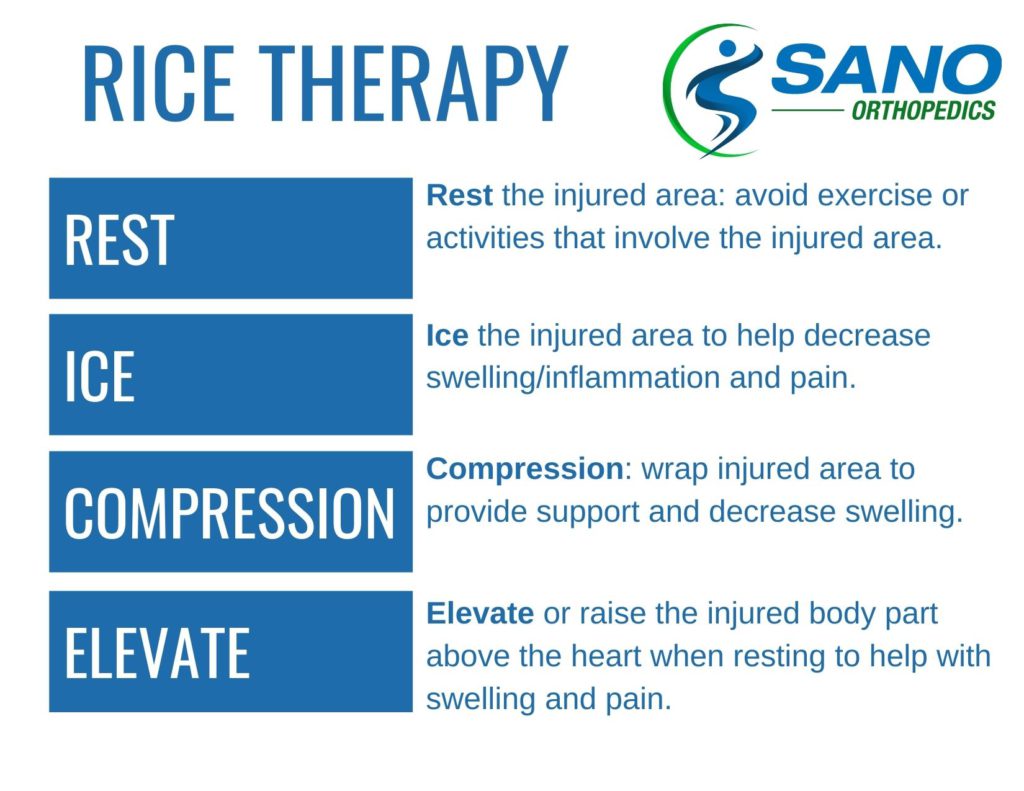What does RICE stand for?
REST. ICE. COMPRESSION. ELEVATE.
For minor strains and sprains, the first recommendation often involves RICE treatment. These 4 steps include resting the injured area, applying ice to your injury, using compression wrap to support the injury, and elevating the body part to reduce swelling. Follow these 4 steps to reduce swelling and decrease pain immediately following an ankle sprain, knee strain, or other soft tissue injuries.
These steps are recommended immediately following an acute injury up to 48 hours following. Let’s go over these 4 steps in more detail.
Rest.
Stop activity right away and take pressure off the injured limb. This may mean taking weight off your injured ankle or not using the injured elbow. Protect your injured body part; plan to take it easy until you can use the body part without pain.
Ice.
Use an ice pack on the injured body part to help decrease swelling/inflammation and dull the pain. Ice the injury for up to 20 minutes at a time, allowing for at least 20 min between icings. Use a thin towel or clothing between the ice and your skin. Like rest, ice the area off and on for 24 to 48 hours after the injury.
Compression.
To decrease swelling and reduce pain, use an ACE wrap or compression sleeve to provide support. Compress the injury by wrapping it firmly, but not too tightly. An elastic bandage is important because it can expand, allowing blood to flow through the injury area. Compression wraps may be recommended up to 72 hours after the injury.
Elevation.
Elevation is the last step of RICE treatment therapy. When resting, raising the injured body part above the heart will help reduce swelling and pain management. Elevating the injured body part aids circulation by allowing your blood to cycle through the injured area and back toward the heart.
What’s after RICE Treatment?
Excess swelling can cause a great deal of pain and RICE treatment steps can relieve this initial pain. The ice in particular helps with soreness and inflammation. RICE treatment is a key part of getting patients past the initial pain-and-swelling hurdle so they can start exercising and begin healing. This is not an ongoing treatment.
If you feel you have a more serious injury, such as suspicion of a fracture/broken bone or the inability to bear weight / move the body part, do not hesitate to contact your primary care provider or seek an Orthopedic Urgent Care for further evaluation. Also, if your pain is not going away or continues to worsen, it is a good idea to have a formal evaluation by medical provider.

RICE therapy: a new debate
There is, however, an abundance of newer research that collectively supports the notion that ice and rest does not enhance the recovery process. Instead, ice delays recovery and may result in further damage to the tissue.
If you have any questions, contact your medical provider.
Need to be seen today? We have walk-in orthopedic urgent care clinics.
Recent News
Physical Therapist to Surgeon: Dr. Rob Comrie’s Journey in Joint Replacement
Dr. Rob Comrie’s journey from a physical therapist to an orthopedic surgeon is not just a career transition but a testament to the profound impact of diverse experiences in shaping his medical practice.
Bringing Care Closer: New Office in Raymore, MO
Bringing Care Closer: New Office in Raymore, MOAt Sano, our commitment to providing exceptional health care takes a new step forward with the unveiling of our latest office in Raymore, Missouri. Scheduled to open its doors in late March, this new office allows us to...
Sano Evolution: Adding Expertise and Services in 2023
Sano Orthopedics year in review! Adding new providers, specialties, and offices, 2023 was a year of growth for Sano. Reflecting on the year and looking ahead!
